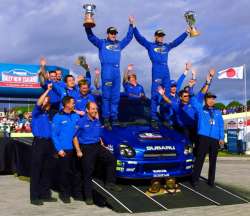
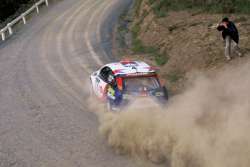
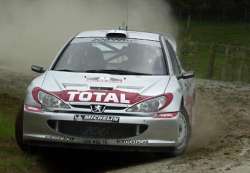
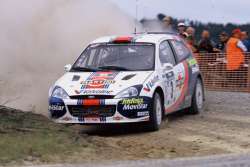
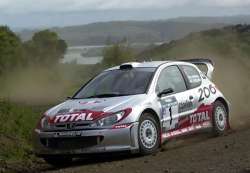
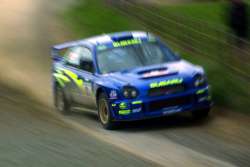
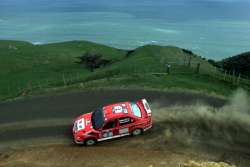

|
|
The 2001 New Zealand Rally - review
Story by Andrew Frampton - October 2001.
In an event dominated by tactics, it was Richard Burns who triumphed on the gravel-strewn roads, to move into contention for the driver's title. Second place for Colin McRae means that he is now equal leader of the championship with Mitsubishi's Tommi Mäkinen who finished outside the point scoring positions.
By virtue of his first position in the driver's standings, Mäkinen had to run first through the stages, and through the deep gravel that he would sweep off the road for the following cars. The Finn would drop to a lowly 14th by the end of day one. Leading the charge on day one was the 2000 champion Marcus Gronholm (Peugeot). He traded fastest times on day one with impressive youngster Petter Solberg (Subaru), both running well due to low championship positions.
The Ford Focuses of Colin McRae and Carlos Sainz were second and third in the championship coming into the New Zealand round, and were attacking as hard as they could to overcome the disadvantage of having to run through the stages early. As the end of Leg One drew near, it was obvious that road position for Day Two was of vital importance to most drivers. The Subaru pairing of Richard Burns and Robert Reid would drop time on the final stage in an attempt to start further down the leaderboard on day two. They would finish the day in ninth place, just behind Alister McRae, brother of Colin, in the Hyundai. Francois Delacour was in seventh, just behind Mitsubishi's number two driver, Freddy Loix, who was only 44 seconds off the lead in sixth.
Solberg lost time with engine management problems on the final stage and would drop to fifth. The Ford twins of Sainz and McRae were third and fourth deciding not to play the tactics game and drive flat out - setting the fastest two times on the final stage. Despite dropping 40 seconds off the final stage, Gronholm was in second, and very unhappy with the Peugeot team, who fed him misleading information about how much time to drop. This meant that the overnight leader was the Hyundai of Kenneth Eriksson/Staffan Parmander, which hadn't missed a beat all day. This was the first time that Hyundai had led a leg of a World Championship rally.
With the rally moving from the South, to the North of Auckland for day 2, it was clear that Eriksson's position atop the leaderboard was not going to last, the Swede losing nearly two minutes on the day's first stage. The Peugeot of Harri Rovanpera/Risto Pietiliainen was the fastest through the day's first, and the rally's longest stage, with Burns less than half a second slower. Burns then proved that his tactics on day one had paid off, setting the fastest times through the next four stages, despite sliding into a bank on SS13. And while Didier Auriol (Peugeot) was fastest on the next stage, Burns took the last two stage victories and a 42-second advantage into the overnight service halt. A succession of second fastest times had moved Rovanpera into third position, the Finn another driver choosing to run down the order. Between the two 'tacticians' was Colin McRae, who had driven to the limit all day and held a 20-second advantage over Rovanpera.
Next up were Sainz and Gronholm, in fourth and fifth, who had managed to perform their task of damage limitation running so high up the order after day one. Didier Auriol would have been ahead of team leader Gronholm, if he had not decided to drop four seconds on the final stage, so that he would run behind him on Leg 3. Mäkinen had been able to claw back some of the time he had lost on the first day, and had moved up to seventh ahead of Solberg, who suffered gearbox gremlins. Alister McRae was in ninth, ahead of Loix and Leg One leader Eriksson, who had lost a significant amount of time sweeping the roads on day 2.
Day 3 would see three of the stages run twice over, reducing the amount of time that the leading cars would lose. Even so, Burns could only manage 15th fastest time on the day's opening stage. This allowed McRae to claw back some of the lead that Burns had pulled out on day 2. Faster again through the second stage, McRae had reduced his deficit to just 21 seconds. McRae was quicker than Burns through the next four stages, including setting two fastest times. This meant that with two to go, the gap had been reduced by another seven seconds. However, McRae's good work would be undone by a time consuming spin and stall on the penultimate stage that cost him 30 seconds. All that Burns needed to do was cruise through the final stage to take victory, and that's what he did, with an eventual margin of 45 seconds back to McRae.
Only 12 seconds covered the 2nd - 5th place finishers, with Rovanpera taking third despite a spin early on the final day. He held onto third from Sainz, who must have thought he was heading towards second spot, before a spin and two punctures dropped him down the order with two stages left to run. Gronholm was fifth, but would have finished in third if he had not been given a ten-second penalty for jumping the start of the final stage. Auriol's tactic of dropping behind team-mate Gronholm for the final day didn't pay off - he finished in sixth position. The man on a charge during the final day was Solberg, who was quicker than Mäkinen on all but one stage of the final day to claim the Finn's seventh position on the final stage. Behind Mäkinen were the Hyundais, with Alister McRae finishing just ahead of Eriksson.
Loix ended the event 11th, one place ahead of Delacour, who had rolled his car on day two. Subaru's Toshi Arai (14th) and the points nominated Mitsubishi of Toni Gardermeister (15th) didn't impress, but for the first time in many years, all 14 works cars finished the event.
Burns' win moves him into third in the driver's standings, just nine points behind joint leaders Mäkinen and McRae.
The series now moves onto the first of an asphalt double-header, with the Rally San Remo (Italy), starting on October 4th.
Relevant links:
The 2001 WRC season
Rally San Remo (Italy) preview
|










